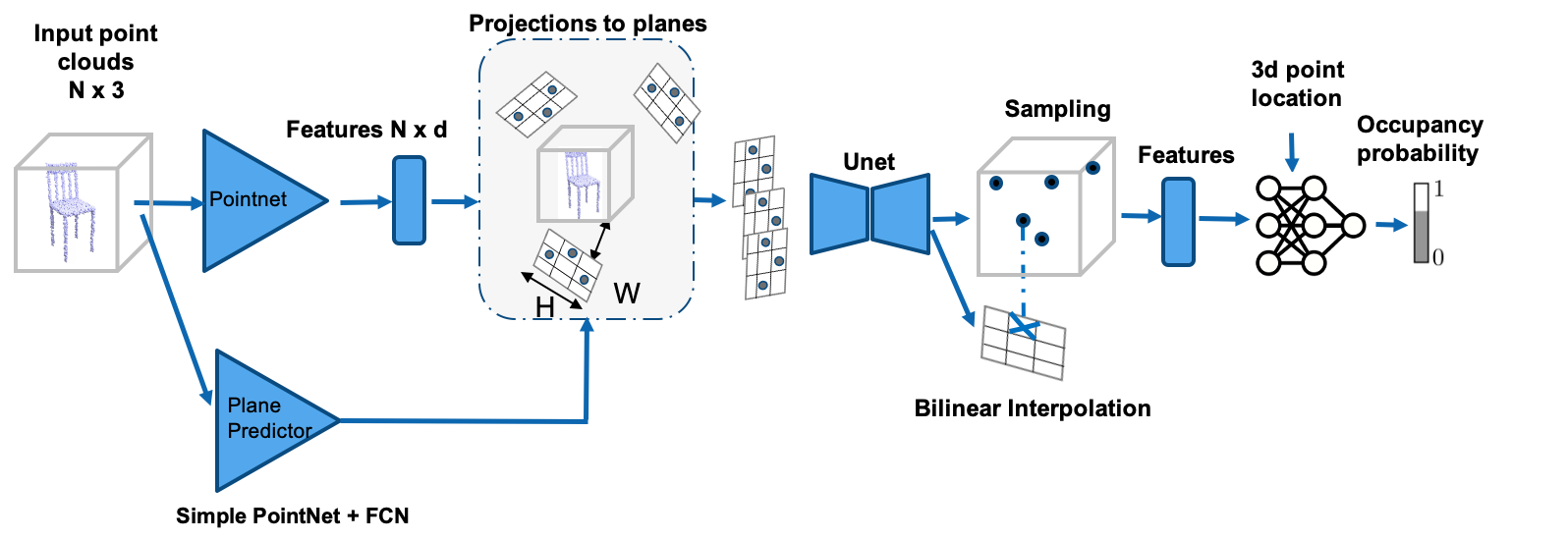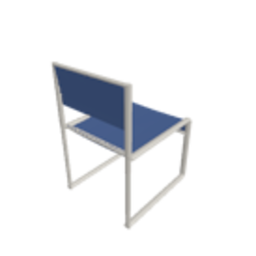Dynamic Geo Convolutional Occupancy Network
 This repository contains the code for Dynamic Geo Convolutional Occupany Networks as extended work of Convolutional Occupancy Networks.
This repository contains the code for Dynamic Geo Convolutional Occupany Networks as extended work of Convolutional Occupancy Networks.
You can find detailed usage instructions for training your own models and using pretrained models below.
Table of Contents
- Installation
- Demo
- Dataset
- Files Architecture
- Implementation description
- Training
- Generation
- Generation with Rotation
- Evaluation
- Visualisation of learned planes
- Saved models
- Saved meshes of evaluation
You may go to spheres readme Contribution guidelines for this project
Installation
First you have to make sure that you have all dependencies in place. The simplest way to do so, is to use anaconda.
You can create an anaconda environment called mesh_funcspace using
conda env create -f environment.yaml
conda activate mesh_funcspace
Next, compile the extension modules. You can do this via
python setup.py build_ext --inplace
To compile the dmc extension, you have to have a cuda enabled device set up.
If you experience any errors, you can simply comment out the dmc_* dependencies in setup.py.
You should then also comment out the dmc imports in im2mesh/config.py.
Install Pytorch scatter extension
Upgrade Pytorch to 1.4.0
conda install pytorch==1.4.0 cudatoolkit=10.0 -c pytorch
Install Pytorch scatter
pip install torch-scatter==latest+cu100 -f https://pytorch-geometric.com/whl/torch-1.4.0.html
Demo
You can now test our code on the provided input images in the demo folder.
To this end, simply run
python generate.py configs/demo.yaml
This script should create a folder demo/generation where the output meshes are stored.
The script will copy the inputs into the demo/generation/inputs folder and creates the meshes in the demo/generation/meshes folder.
Moreover, the script creates a demo/generation/vis folder where both inputs and outputs are copied together.
Dataset
To evaluate a pretrained model or train a new model from scratch, you have to obtain the dataset. To this end, there are two options:
- you can download our preprocessed data
- you can download the ShapeNet dataset and run the preprocessing pipeline yourself
Take in mind that running the preprocessing pipeline yourself requires a substantial amount time and space on your hard drive. Unless you want to apply our method to a new dataset, we therefore recommmend to use the first option.
Preprocessed data
You can download our preprocessed data (73.4 GB) using
bash scripts/download_data.sh
This script should download and unpack the data automatically into the data/ShapeNet folder.
Building the dataset
Alternatively, you can also preprocess the dataset yourself. To this end, you have to follow the following steps:
- download the ShapeNet dataset v1 and put into
data/external/ShapeNet. - download the renderings and voxelizations from Choy et al. 2016 and unpack them in
data/external/Choy2016 - build our modified version of mesh-fusion by following the instructions in the
external/mesh-fusionfolder
You are now ready to build the dataset:
cd scripts
bash dataset_shapenet/build.sh
This command will build the dataset in data/ShapeNet.build.
To install the dataset, run
bash dataset_shapenet/install.sh
If everything worked out, this will copy the dataset into data/ShapeNet.
Files Architecture
When you have installed all binary dependencies and obtained the preprocessed data, you are ready to run our pretrained models and train new models from scratch.
Directory layout
├── src # Source files
├── img # Images for README
└── README.md
Source files
├── ...
├── src
│ ├── point_plane_net # main code for dynamic planes
│ ├── sphere_encodings # code for sphere encodings
│ ├── rotation_generation # code for gen with rotation
│ ├── triplet_loss_planes # code for triplet loss
├── visualisation_planes # code for learned planes visualisation
├── experiments # code for Point-Plane-Net implementation,
# rotations experiments
│
└── ...
Implementation description
We have implemented:
- Encoder
- Planes Encoder
- Sphere Encoder
- Decoder
- Planes Decoder
- Sphere Decoder
- Visualisation of planes
- Meshes generation of Rotated objects
- Triplet Loss
- Plane-Height-Map
| Branch name/Contents | Encoder | Decoder | Rotation |
|---|---|---|---|
| master branch | im2mesh/encoder/fc_point_net.py im2mesh/encoder/__init__.pyconv_onet/im2mesh/encoder/pointnet.pyconv_onet/im2mesh/encoder/__init__.py |
im2mesh/onet/models/decoder.pyim2mesh/onet/models/__init__.py conv_onet/im2mesh/onet/models/decoder.py conv_onet/im2mesh/onet/models/__init__.py |
|
| sphere branch | im2mesh/encoder/fc_point_net.py im2mesh/encoder/__init__.py im2mesh/encoder/additional_encoders.py |
im2mesh/onet/models/decoder.py im2mesh/onet/models/__init__.py |
|
| fc_plane_prediction | generate_rotation.py eval_meshes.py im2mesh/onet/generation.py im2mesh/onet/training.py train_point_plane_rotate.py |
| Branch name/Contents | Triplet Loss | Visualisation |
|---|---|---|
| triplet loss | im2mesh/onet/models/__init__.pyim2mesh/onet/config.py im2mesh/onet/training.py im2mesh/encoder/additional_encoders.py |
- |
| visualisation planes | - | normal_per_class.py generate_plane_vis.py |
To run the code of one of implemented regimes go to corresponding branch folder and follow their README
Training
In all config files specify in data/path the actual path to your Shapenet dataset.
Training Point Plane Net
Follow this Readme
Training Dynamic Plane + Height Map Convolutional Occupancy Network
Follow this Readme
Training Dynamic Plane + Spheres Convolutional Occupancy Network
Follow this Readme
Training Dynamic Plane Convolutional Occupancy Network With Triplet Loss
Follow this Readme
You should specify margin_triplet in training part. Choose triplet_fc_plane_net as class model in encoder, cbatchnorm in decoder
Generation
To generate meshes using a trained model, use
python generate.py CONFIG.yaml
where you replace CONFIG.yaml with the correct config file.
The easiest way is to use a pretrained model. You can do this by using one of the config files
configs/img/onet_pretrained.yaml
configs/pointcloud/onet_pretrained.yaml
configs/voxels/onet_pretrained.yaml
configs/unconditional/onet_cars_pretrained.yaml
configs/unconditional/onet_airplanes_pretrained.yaml
configs/unconditional/onet_sofas_pretrained.yaml
configs/unconditional/onet_chairs_pretrained.yaml
which correspond to the experiments presented in the paper.
Our script will automatically download the model checkpoints and run the generation.
You can find the outputs in the out/*/*/pretrained folders.
Please note that the config files *_pretrained.yaml are only for generation, not for training new models: when these configs are used for training, the model will be trained from scratch, but during inference our code will still use the pretrained model.
Generation with Rotation
Follow this Readme
Evaluation
For evaluation of the models, we provide two scripts: eval.py and eval_meshes.py.
The main evaluation script is eval_meshes.py.
You can run it using
python eval_meshes.py CONFIG.yaml
The script takes the meshes generated in the previous step and evaluates them using a standardized protocol.
The output will be written to .pkl/.csv files in the corresponding generation folder which can be processed using pandas.
For a quick evaluation, you can also run
python eval.py CONFIG.yaml
This script will run a fast method specific evaluation to obtain some basic quantities that can be easily computed without extracting the meshes. This evaluation will also be conducted automatically on the validation set during training.
All results reported in the paper were obtained using the eval_meshes.py script.
Visualisation of learned planes
Follow this Readme
Saved models
You can find saved weights of our models following this link
Saved meshes of evaluation
You can find quantitative results of meshes at evaluation of our models following this link
Futher Information
Please also check out the following concurrent papers that have proposed similar ideas: *




